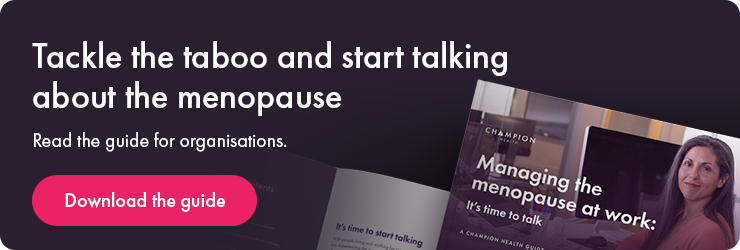Learning how to work during the menopause is crucial because this transitional part of your life can significantly impact your career – and unfortunately, it’s often for the worse.
In fact, almost half of women find that their career is negatively impacted by the menopause – and this is often made worse by societal stigma and taboos.
Ultimately, the menopause does not have to result in women suffering in silence within the workplace. It does not require women to cut their careers short. And it does not need to be shrouded in stigma, secrecy and misinformation.
In this article, you’ll discover what you can do to manage the menopause at work so you can continue progressing your career. You’ll cover:
- What is the menopause?
- Menopause myths debunked
- How can the menopause affect you at work?
- How to work during the menopause
We’ve also put this key information together into a free guide: Managing the Menopause at Work: It’s Time to Talk.
Are you an employer? If so, read this guide covering what organisations can do to support those going through the menopause.
What is the menopause?
The menopause describes a time when a woman’s oestrogen levels decline and she stops having periods.
It usually occurs between the ages of 45 and 55, with an average age of 51 in the UK. However, this can vary between women, depending on genetic and lifestyle factors.
Symptoms of the menopause usually start a few years before a woman’s period stops (known as the perimenopause) and can continue for some time after – however this does vary.
On average, the menopause lasts for around 4 years in total, but 1 in 10 women experience symptoms for up to 12 years.
Everyone experiences the menopause differently. Symptoms can fluctuate and be felt to various degrees.
However, there are common symptoms to look out for, including:
- Psychological changes, such as mood disorders, memory loss, reduced concentration and loss of confidence
- Hot flushes (brief and sudden surges of heat usually felt in the face, neck and chest)
- Muscle and joint stiffness, aches and pains
- Weight gain
- Headaches
- Weight gain
- Heart palpitations (heartbeats that become more noticeable)
- Skin changes, such as dryness, acne and general itchiness
- Reduced sex drive
- Difficulty sleeping
- Vaginal dryness
Menopause myths debunked
The menopause is a topic surrounded by misinformation, which can be extremely damaging for those going through it, or trying to support someone else who is.
Here are three common menopause myths debunked:
Myth: You only experience menopause after the age of 50
Truth: It is possible to go through menopause from the age of 30 onwards. In fact, 1 in 100 women experience the menopause before 40 and research shows that the average age a woman experiences perimenopause is 46.
Myth: Hot flushes are the only symptoms of the menopause.
Truth: There are over 30 symptoms of the perimenopause and the menopause. Hot flushes are not even the most common! You shouldn’t hesitate to get help if you’re experiencing other symptoms, which are impacting your day-to-day life.
Myth: It’s best not to risk Hormone Replacement Therapy (HRT)
Truth: The benefits of HRT outweigh the risks for most women, and it can be an incredibly effective option for many women in treating their menopause symptoms. Find out more about this from the NHS.
How can the menopause affect you at work?
For many women, this transitional period is tough. Often, there are potentially embarrassing and stressful symptoms, made worse by society’s negative perception of the menopause.
As a result, you may feel isolated, stressed and burnt out. But you won’t be alone, an alarming 9 out of 10 women say they feel unable to talk to managers at work.
The combination of these potentially debilitating physical symptoms alongside this already stigmatised topic means the menopause can have a massive impact on you at work.
That’s why it’s crucial you know how to work during the menopause – dive into that below.
How to work during the menopause
Although it’s by no means easy, adopting a positive attitude and equipping yourself with the knowledge and skills to cope with the menopause symptoms has been shown to improve quality of life for those going through it.
Below, you’ll find steps you can take to get the support you need and help you thrive in the workplace.
1. Get the right support fast
As a starting point, if your symptoms are having a negative impact on your work, you should access support via your GP, as well as speaking to your manager about reasonable adjustments or an occupational health referral.
Any symptoms that persist for a year or more and are affecting your performance at work can be considered a long-term health condition, and so any adjustments should be made in line with the relevant workplace policy.
If you need external support aside from your GP, try these services and resources:
2. Speak to your manager
It might feel embarrassing to talk about the menopause with your manager, but it’s so important to do so.
It’s crucial you can speak openly about the adjustments you might need, to ensure the best support is put in place for you.
Open up the conversation in a way that feels comfortable for you, here are some pointers to start talking:
1. Prepare notes – It can be hard asking for adjustments. That’s why it’s key to note down how your symptoms are affecting you day-to-day. Use this to remind yourself how important it is to get support from your employer – it can be easy to forget how much of a struggle some days are if you don’t note it down!
2. Book a private chat or one-to-one – Inform your manager you want to discuss a personal matter in private and book a meeting. You don’t want to discuss something so important in an ad-hoc way. Instead, give it the time and privacy it deserves.
3. Explain clearly – For many, the menopause is a mystery. With that in mind, it’s important you know the facts and take the time to explain away the myths, giving your manager a realistic understanding of the challenges, you might be facing. Read our guide on raising menopause awareness for tips.
4. Offer solutions – Work with your manager to find supportive adjustments that still allow you to work effectively. Read up on potential adjustments your employer could offer you in our guide: Menopause at work: What organisations can do.
5. Keep the conversation going – Aim to pencil another meeting in, after a few months, so you can update your manager on the effectiveness of the adjustments you’ve agreed. This will help your manager learn what works, and might even help spread awareness that symptoms of the menopause can be supported within the workplace.
While many of us may feel comfortable talking to our managers, that’s not always the case. If you’re unable to speak to a manager, consider talking to a trusted colleague, senior leader or the manager of another team. They can all help you by listening with empathy and signposting you to the correct resources
3. Share your experience
Building a support network around you and reaching out for help can ease feelings of loneliness and help you cope better with the changes that are happening.
Opening up to your family or partner and educating them on the menopause has also been shown to reduce feelings of depression and anxiety, whilst strengthening the emotional connection within your relationship.
By doing this you’ll also help raise important menopause awareness.
4. Learn about workplace adjustments
There are resources available to inform you of the workplace adjustments that can be made, including our guide on Menopause at work: What organisations can do.
You can also check if your organisation has a menopause policy or a dedicated menopause champion or support group.
5. Understand the lifestyle factors
There are many lifestyle factors that can help you manage the menopause at work, including:
1. Eat regular and well-balanced meals
Declining levels of oestrogen and progesterone can cause your blood sugars to fluctuate, which can make you feel shaky and light-headed.
When you miss or delay a meal, this can make it even worse, so try to maintain your blood sugar levels by eating regularly throughout the day.
2. Eat foods rich in calcium and vitamin D
The decline in oestrogen experienced during the menopause can lead to low bone mineral density, increasing your risk of developing osteoporosis.
To keep your bones strong and healthy include, green leafy vegetables such as; watercress, kale and broccoli. You should also include oily fish (e.g. salmon, sardines), milk, yoghurt and cheese in your diet – if you’re dietary requirements enable you to do so.
3. Eat wholegrains, fruit and vegetables everyday
Research shows that eating a diet high in refined carbohydrates can result in the menopause starting nearly two years earlier than it otherwise would.
Swap refined carbohydrates, such as white bread, rice and pasta for wholegrain alternatives, which will also provide you with more fibre and help to regulate blood sugar levels.
4. Reduce your alcohol consumption
Regular alcohol consumption can worsen menopausal symptoms, increasing your risk of hot flushes and night sweats.
These in turn will have an effect on your sleep, tiredness and energy levels. If you drink regularly, try to “drop a drink size” or have a few drink-free days per week to see if your symptoms improve.
5. Reduce your caffeine intake
Caffeine from tea, coffee and fizzy drinks may worsen menopausal symptoms, particularly hot flushes and poor sleep.
Try to reduce your intake by having caffeine free alternatives. It is also important to stay well-hydrated, as changes in your body temperature can lead to increased water loss (e.g. through sweating).
Keep a water bottle handy to keep track of how much you are drinking, which will also help you stay cool during hot flushes.
6. Engage in regular physical activity
We recommend doing a least 150 minutes of moderate physical activity per week. This can include going for a brisk walk, a light jog or a bike ride.
Even doing the housework or gardening allows you to get your heart rate up and move your body. Exercise will not only improve your physical health but will also improve your mental health, making you feel good about yourself.
7. Utilise strengthening exercises
You do not need to go to the gym or lift heavy weights to strengthen your muscles; you can simply do this at home with just your body weight.
There are lots of online workouts you can search for, when doing these, aim for large muscle groups including exercises such as squats or press ups.
Find what works for you
Managing the menopause at work can be extremely tough, and this is exacerbated by the fact that it’s still rare for women to talk openly about their experiences, perhaps out of fear of not being taken seriously or being told to ‘just get on with it’.
It’s important to realise you do not deserve to have your capacity to work decreased because you cannot get the support you are entitled to.
Although it’s difficult, taking the steps to manage your menopause at work could be life-changing.
So, take on that taboo – one conversation at a time.





